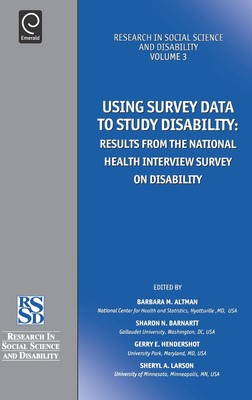
- We will send in 10–14 business days.
- Publisher: Jai Press Inc.
- ISBN-10: 0762310073
- ISBN-13: 9780762310074
- Format: 15.6 x 23.4 x 2.1 cm, hardcover
- Language: English
- SAVE -10% with code: EXTRA
Using Survey Data to Study Disability (e-book) (used book) | bookbook.eu
Reviews
Description
The 1994-95 Disability Supplement to the National Health Interview Survey (NHIS-D) sponsored by the US Department of Health and Human Services provided a rich resource for the quantitative studies included in this volume. Nationally-epresentative surveys that focus on collecting more in depth information about persons with disabilities are rare, therefore these studies are unusual in the level of data they include and the important insights into disability issues that they provide. These come at a time when much more information about the experiences of disability is needed to inform policy and evaluate programmatic changes. The first paper of the volume discusses in detail the genesis and methodology of the NHIS-D. This volume contains a variety of different types of papers that add not only to our information about persons with disabilities, but also serve as a useful guide to using this extensive data set to address the numerous questions about this population. In the first section, two papers describing methodological issues in using the NHIS-D are described. This section includes a paper on response patterns and another on a strategy to overcome the problem of missing data. The next section contains three papers that use the NHIS-D to develop a variety of operational definitions of disability and then use those operational definitions to describe specific aspects of disability, including aging, the International Classification of Functioning, Disability and Health, and intellectual and developmental disabilities. The third section uses the NHIS-D to identify limitations and barriers experienced by persons with disabilities. Included in this group of papers are topics addressing barriers to work, mobility limitations and health care services, and unmet needs for support services among children.
EXTRA 10 % discount with code: EXTRA
The promotion ends in 18d.22:15:06
The discount code is valid when purchasing from 10 €. Discounts do not stack.
- Publisher: Jai Press Inc.
- ISBN-10: 0762310073
- ISBN-13: 9780762310074
- Format: 15.6 x 23.4 x 2.1 cm, hardcover
- Language: English English
The 1994-95 Disability Supplement to the National Health Interview Survey (NHIS-D) sponsored by the US Department of Health and Human Services provided a rich resource for the quantitative studies included in this volume. Nationally-epresentative surveys that focus on collecting more in depth information about persons with disabilities are rare, therefore these studies are unusual in the level of data they include and the important insights into disability issues that they provide. These come at a time when much more information about the experiences of disability is needed to inform policy and evaluate programmatic changes. The first paper of the volume discusses in detail the genesis and methodology of the NHIS-D. This volume contains a variety of different types of papers that add not only to our information about persons with disabilities, but also serve as a useful guide to using this extensive data set to address the numerous questions about this population. In the first section, two papers describing methodological issues in using the NHIS-D are described. This section includes a paper on response patterns and another on a strategy to overcome the problem of missing data. The next section contains three papers that use the NHIS-D to develop a variety of operational definitions of disability and then use those operational definitions to describe specific aspects of disability, including aging, the International Classification of Functioning, Disability and Health, and intellectual and developmental disabilities. The third section uses the NHIS-D to identify limitations and barriers experienced by persons with disabilities. Included in this group of papers are topics addressing barriers to work, mobility limitations and health care services, and unmet needs for support services among children.


Reviews